Game Marketing Game marketing is a multifaceted domain that demands creative reasoning. Recently, I was tasked with responding to two questions related to game marketing and decided to expand on this reflection.
So, I present the questions and my responses:
- #1 Scenario:
Let’s say a game is under development and will be released in 6-8 months. What would your process be for creating a strategy considering budget, sales goals, user acquisition, campaigns, reports, etc.? - #2 Scenario:
Suppose a game is not performing well. How would you create a plan to optimize sales?
These were the main challenges I needed to address. Considering my professional trajectory and my proposal at Sankofa Games, I decided to express how I approach these challenges.
IMPORTANT: in fact there is no right or wrong answer. So, the purpose of this text is to present a way to outline an action plan. Of course, specific and detailed study and dedication is what will favor success in creating strategies.
Game Marketing – #1 Scenario
Let’s say a game is under development and will be released in 6-8 months. What would your process be for creating a strategy considering budget, sales goals, user acquisition, campaigns, reports, etc.?
The process begins with a comprehensive analysis and I have decided to dissect it into topics listed below with their respective descriptions. Initially, I considered 6 (six) essential steps to present my logic. Check it out:
STEP 1 OF 6 – SITUATION ANALYSIS
It starts with evaluating the market, competition and the target audience to understand where each stakeholder1 is at. This will contribute to a holistic view and progress to the next steps. Therefore, conducting market research, analyzing demographic data and updating on trends in the gaming industry and consumer behaviour is fundamental to understanding the current scenario and identifying opportunities.
STEP 2 OF 6 – DEFINING OBJECTIVES
From the immersion carried out in the previous phase, it is already possible to establish objectives such as specific sales targets, user acquisition and KPIs (key performance indicators2). This will help to define the results we want to achieve with the launch.
STEP 3 OF 6 – BUDGET
How much does a game marketing campaign cost?
The ideal answer to this question is: it depends!
After all, according to the objectives defined in the previous step, we will have the metrics, indicators and KPIs that will determine the success or failure of the actions. So, allocating financial resources does not always mean that R$10 will be enough or that, it is only possible to create a digital campaign with R$10 million.
In this stage, it is important to understand which actions will be carried out, for example, paid advertising, content marketing, events, partnerships, influencer marketing, and affiliates, among other tactics.
The crucial point here is the flexibility for the budget to be adaptable, allowing adjustments according to the need or growth of the campaign.
I always like to mention from my experience that managing a tight budget can generate as much result as having the chance to work with high values. In my portfolio, I present a crowdfunding campaign that, by using R$200 in paid traffic on social networks, generated R$9 thousand in funds for an NGO. For the challenge in particular. Amid the Covid-19 pandemic, this was a milestone for the institution.
So how do you define the budget?
This topic would give an exclusive article to talk only about. However, I will extend my reasoning and how I work with my clients.
To determine the budget. I consider the CAC (Customer acquisition cost) and the LTV (Lifetime Value). Of course, at a time without much data, it is necessary to estimate how much the company is willing to pay to acquire a customer, therefore, we have a goal to evaluate the success of marketing actions guided by revenue and, also the data that will be generated.
Regarding LTV, we need to understand how much revenue each person generates when they buy the game or make in-app purchases if it is a freemium3 application. With this data, even if only estimated, we can determine how much flexibility there is in spending to acquire new users.
Calculating the CAC
The CAC in this scenario includes marketing costs and the number of players acquired. The formula we use to get the quotient is:
Marketing costs / players-users acquired = result
i.e. if the global marketing costs are R$20,000 and the result of the launch is 2,000 players, the formula will be like this:
CAC = R$20,000 / 2000 = R$10 per player
So, the average acquisition cost for each new person playing is R$10.
Calculating the LTV
The LTV is the customer’s lifetime value. This KPI tracks the average revenue each person generates over time. To find out this metric, we need to understand how long the average relationship of each player with the game is, in addition to the value generated over time and, this includes ads viewed, subscriptions, purchases, etc. So, the formula to obtain the product considers:
Average Revenue per player / Average relationship duration = result
So, in this hypothetical scenario, we will exemplify with a revenue of R$10 and a period of 7 months in the use of the game, that is, relationship.
LTV = R$10 x 7 = R$70 per player
Therefore, the average value of a player throughout their lifetime is R$70.
With the estimated CAC and LTV data, it is possible to analyze marketing strategies. The thermometer starts with the CAC because if it is significantly lower than the LTV. It means that the acquisition is on the right track or ideal.
But, if the scenario is the opposite, where the CAC is higher than the LTV, it will be necessary to urgently review the actions in progress to determine modifications to improve the game’s profitability.
Finally, I also reinforce the importance of analyzing metrics such as ROI (Return on Investment) and ROAS (Return on Ad Spend). To make it easier, I will bring this reflection to step 6.
STEP 4 OF 6 – CAMPAIGN STRATEGY
With the objectives and budget in mind, creating a campaign strategy that includes details about the key messages, distribution channels (social media, paid advertising, email marketing, etc.) and the campaign launch schedule is essential.
Following the logic of exposing my reasoning, here I would distribute actions throughout the pre-launch months. Check it out:
Creating Momentum – Months 1 and 2
- Setting Objectives: This could include the number of social media followers, email list sign-ups, and interactions with teasers.
- Teasers and Announcements: Using social media and blogs to share this information, along with press releases to distribute game teasers and intriguing information.
- Website and Social Media Creation: Developing a dedicated microsite for the game and building a community on social media.
- Email List Sign-ups: Encouraging interested individuals to sign up for an email list to receive exclusive updates and news about the game, possibly offering a lead magnet to increase the lead base through this action.
Pre-Registration – Months 3 and 4
- Reveal: At the beginning of the third month, make an official reveal of the game with the launch trailer and detailed information about features and gameplay.
- Pre-Registration Campaigns: Conduct pre-registration campaigns through online events via Twitch to invite players to sign up. Also, offer exclusive rewards to encourage registration.
- Content Development: Share interesting content, such as behind-the-scenes videos, interviews with developers, and exclusive previews for the community.
- Community Engagement: Activate the community to keep them engaged through contests, polls, and responses to player questions.
Pre-Launch – Starting from Months 5 and 6
- Event: Depending on the available budget, hosting an in-person event can involve the media to increase coverage and outreach.
- Beta Pre-Launch: If applicable, start a closed beta version of the game and engage active community players.
- Communication: Maintain constant communication with the community, sharing updates about the game’s progress and actively engaging on social media and gaming forums.
Launch and Post-Launch – From Months 7 and 8 Onwards
- Launch: In the final stretch from the seventh or eighth month, execute the official launch, ensuring that the KV (key visual)4 is prepared for this crucial moment.
- Launch Campaigns: Run high-impact marketing campaigns on launch day, including paid advertisements, blog posts on gaming sites, and engaging a team of influencers.
- Follow-Up: Closely monitor the game’s performance and marketing metrics after the launch. Make adjustments based on the data and continue engaging the community with regular updates and special events, possibly alternating between online and offline actions.
- Player’s Feedback: Listen attentively to the feedback from the gaming community and make improvements to the game based on their suggestions.
In light of the game launch schedule, I would test. This example considers a proposed duration of 6 to 8 months. However, the exact duration of each phase may vary depending on the game, target audience, objectives, and available resources.
In general terms, the marketing funnel should be applied to build hype, engage the community, and maximize the impact of the launch. Therefore, the post-launch follow-up phase is equally important to keep the game relevant and successful long-term.
STEP 5 OF 6 – PLAYER ACQUISITION
Basically, this step involves intricacies in user acquisition plans as detailed as possible, and identifying which channels and tactics work best for the target audience. As listed in the previous schedule, this can involve influencer partnerships, pre-registrations, or other methods.
Some frameworks like 5W2H5, SMART6, and the CSD matrix7 can be useful for decision-making support.
STEP 6 OF 6 – MONITORING AND REPORTING
Implement tracking and report automation tools to analyse data such as ROI, ROAS, conversion rate, among others, to facilitate real-time campaign performance measurement. This allows us to adjust strategies as necessary.
For this step, which is an ongoing activity, and following the hypothetical scenario where the Customer Acquisition Cost (CAC) is R$10 per player and the Lifetime Value (LTV) is R$70 per player, we can calculate the ROI (Return on Investment) and ROAS (Return on Advertising Spend) as follows:
ROI = (LTV – CAC) / CAC
i.e. an ROI of 6 equals 600%, meaning that for every R$1 invested in player acquisition, the company obtains a return of R$6 in revenue over time.
ROI = (70 – 10) / 10
ROI = 60 / 10
ROI = 6
ROAS is an interesting metric for evaluating each campaign individually. Let’s assume the investment is R$10,000 in online advertising to promote the new game. After launching this specific advertising campaign, the ads generated R$50,000 in sales revenue. To calculate ROAS, the formula is:
ROAS = Advertising Revenue / Advertising Costs
i.e. a ROAS of 5 equals 500%, meaning that for every R$1 invested in advertising, the company generated R$5 in revenue.
ROAS = 50.000 / 10.000
ROAS = 5
This is an expanded reflection on the first scenario presented at the beginning of the article.
Nevertheless, this is not a magic formula. However, it’s a starting point for developing a marketing strategy for games. In practice, actions demand preparation, so I invite you, the reader, to consider which steps might be effective in your professional activity.
In the next scenario, I will be more concise, as the logic will be well presented by what I have written so far. However, if you have any questions, feel free to contact me on Linkedin.
Game Marketing – #2 Scenario
Suppose a title (game) is underperforming. How would you create a plan to optimise sales?
Improving the sales of a poorly performing game requires our attention to rehabilitation and analysis. As you can see from the previous scenario, access to reports, metrics, indicators, and all available data will be crucial for success in creating a strategy.
At this point, I emphasize that besides analysing performance to identify the main issues, collecting feedback can promote new insights. As this stage requires iteration, it’s expected that monitoring is implemented. With that, we can optimise the investigation time.
So, I would highlight the following points:
Problem Investigation
Also, based on data analysis. Once you find specific problematic areas, I would list priorities for a tactical action plan. For example, if player retention is an issue, I would focus on understanding why players are losing interest.
Development of Corrective Strategies
Based on the previous step, I would develop corrective strategies supported by content updates, monetisation adjustments, user experience optimization, and rebranding, depending on the findings. Here, the CSD matrix will be useful.
Testing and Iteration
To grow fast and test constantly. The responsible team must dedicate hours to growth hacking8 thinking and practice. This way, it will be possible to implement strategic changes incrementally and test the impact. This allows us to evaluate what works and what doesn’t, and make real-time adjustments.
Community Communication
Another key point, remember the community? If it’s implemented at some point to support your launch, I would maintain transparent communication with the player community. To keep them informed about improvements and listen to their suggestions.
Some insights will be valuable and can assist the marketing team in course-correcting the product.
Daily Monitoring
Finally, continuous monitoring of performance metrics is essential to ensure that improvements are effective and to make additional adjustments as needed.
Depending on the type of advertisement or campaign, it is possible to space out the data analysis. But in extreme cases, it is highly recommended to review it daily to analyse whether the ongoing actions have a positive impact.
A growth hacking mindset at this stage, as mentioned earlier in the testing and iteration phase. I take the opportunity to absorb a “mantra phrase” from the startup world: fail fast and fix faster.
Above all, considering that time is a decisive factor in making a strategy more expensive, the faster the correction process is adopted, the less costly it will be at the end of a week.
Every good article has a beginning, middle, and end.
I hope it has been a fruitful read.
Also, if you have reached this point, it is probably because Game Marketing is important or relevant in your work.
Understand that everything written above is not the exclusive work of just one person but of a dedicated team supported by a leadership that works together and makes the team perform with mastery.
After all, If you want to discuss this topic further. I invite you to connect with me on LinkedIn. I’m not an influencer. However, I enjoy talking about marketing, strategy, and games. See you soon!
GLOSSARY OF THE ARTICLE ON GAME MARKETING
- stakeholder = in a summarized definition, it refers to individuals and organizations impacted by your company, project, or initiative. ↩︎
- KPI – key performance indicator = performance indicator. ↩︎
- freemium = The combination of the words free and premium results in this term commonly used when referring to a free game that allows in-game purchases, making part of the experience exclusive. ↩︎
- O Key Visual (KV) used as a reference for the communication campaign. It indicates which fonts and colour palettes will be applied to the materials, maintaining visual unity. ↩︎
- The 5W2H framework consists of fundamental questions for an action plan. Check out the details: 5W • What – What will be done? • Why – Why will it be done? • Where – Where will it be done? • When – When will it be done? • Who – By whom will it be done? 2H • How – How will it be done? • How much – How much will it cost? For an expanded reading, access the article. ↩︎
- The SMART framework is common for goal setting. You can read more about it in the article. ↩︎
- CSD Matrix is ideal for project alignment, usually applied at the initial phase of planning, but is still very effective during activities that need review or analysis. Learn more about it in the article. ↩︎
- Growth hacking is a way of thinking and not necessarily a methodology. You can read more about it in the article. ↩︎



